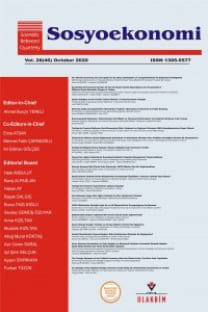Türkiye'de Dış Borç ve Ekonomik Büyüme: Ampirik Bir Analiz
Bu çalışmada Türkiye’de 1970 ile 2016 dönemi zaman serisi verileri Dünya Bankası’ndan alınarak dış borç stoku, dışa açıklık ve tüketici fiyat endeksinin ekonomik büyümeyle olan etkisi araştırılmıştır. Bu amaçla serilerin durağanlıkları analiz edilmiştir. Serilerin birinci dereceden I(1) durağan oldukları belirlendikten sonra ARDL sınır testi yöntemi kullanılarak eşbütünleşme ilişkisi tespit edilmiştir. Elde edilen bulgular ışığında dış borç ekonomik büyümeyi olumlu etkilemekte, dışa açıklık ve tüketici fiyat endeksi ekonomik büyümeyi negatif yönde etkilemektedir. Bu nedenle çalışma, dışa açıklık ve tüketici fiyat endeksinin kontrol altına alınıp dış borç yardımıyla ekonomik büyümeyi artırılabileceğini tavsiye etmektedir.
Anahtar Kelimeler:
Ekonomik Büyüme, Dış Borç, ARDL Bound Testi, Türkiye
External Debt and Economic Growth in Turkey: An Empirical Analysis
This study analyzes the impact of external debt stock, openness and the consumer price index on economic growth, based on time series data obtained from the World Bank for the period from 1970 to 2016. For this report’s purpose, the stability of the series was analyzed. Having identified the series to have first degree l(1) stability, the ARDL bounds testing approach was applied and a relationship of cointegration was established. In light of these findings, it has been observed that external debt has a positive impact on economic growth, while openness and consumer price index have a negative impact. Therefore, this study recommends keeping openness and the consumer price index under control to increase economic growth with the help of external debt.
Keywords:
Economic Growth, External Debt, ARDL Bound Test, Turkey,
___
- Amoateng, K., & B. Amoako-Adu (1996), “Economic Growth, Export and External Debt Causality: The Case of African Countries”, Applied Economics, 28(1), 21-27.
- Avramovic, D (1964), Economic Growth and External Debt, Baltimore The Johns Hopkins Press.
- Azam, M. & C. Emirullah & A.Q. Khan & A.C. Prabharker (2013), “The Role of External Debt in Economic Growth of Indonesia–A Blessing or Burden”, World Applied Science Journal, 25(8), 1150-1157.
- Bentzen, J. & T. Engsted (2001), “A Revival of the Autoregressive Distributed Lag Model in Estimating Energy Demand Relationships”, Energy, 26(1), 45-55.
- Bilginoğlu, M. A. & A. Aysu (2008), “Dış Borçların Ekonomik Büyüme Üzerindeki Etkisi: Türkiye Örneği”, Erciyes Üniversitesi İktisadi ve İdari Bilimler Fakültesi Dergisi, (31), 1-23.
- Calderón, C. & J.R. Fuentes (2013), Government debt and economic growth. Inter-American Development Bank.
- Çelik, S. & T. Başkonuş Direkci (2013), “Türkiye'de 2001 Krizi Öncesi ve Sonrasi Dönemler İçin Dış Borç Ekonomik Büyüme İlişkisi (1991-2010)”, Electronic Turkish Studies, 8(3), 111-135.
- Çiçek, H. & S. Gözegir ve E. Çevik (2010), “Bir Maliye Politikası Aracı Olarak Borçlanma ve Ekonomik Büyüme İlişkisi: Türkiye Örneği (1990-2009)” Cumhuriyet Üniversitesi İktisadi ve İdari Bilimler Dergisi, 11(1), s.141-156.
- Çöğürcü, İ. & O. Çoban (2011), “Dış Borç Ekonomik Büyüme İlişkisi: Türkiye Örneği (1980-2009)”, KMÜ Sosyal ve Ekonomik Araştırmalar Dergisi, 13(21), 133-149.
- Drine, I. & M.S. Nabi (2010), “Public External Debt, Informality and Production Efficiency in Developing Countries”, Economic Modelling, 27(2), 487-495.
- Frimpong, J. M., & E.F. Oteng-Abayie (2006), “The Impact of External Debt on Economic Growth in Ghana: A Cointegration Analysis”, Journal of Science and Technology (Ghana), 26(3), 122-131.
- Ghatak, S. & J.U. Siddiki (2001), “The Use of the ARDL Approach in Estimating Virtual Exchange Rates in India”, Journal of Applied statistics, 28(5), 573-583.
- İpek, E. % B.K. Yaşar (2008), “Türkiye’de Ekonomik Büyüme ve Dış Borç İlişkisi”, Uluslararası Sermaye Hareketleri ve Gelişmekte Olan Piyasalar Uluslararası Sempozyumu, Balıkesir.
- Jayaraman, T.K. & E. Lau (2009), “Does External Debt Lead to Economic Growth in Pacific Island Countries”, Journal of Policy Modelling, 31, 272-288.
- Kharusi, S. A. & M.S. Ada (2018), “External Debt and Economic Growth: The Case of Emerging Economy”, Journal of Economic Integration, 33(1), 1141-1157.
- Korkmaz, S. (2015), “The Relationship Between External Debt and Economic Growth in Turkey”, Proceedings of the Second European Academic Research Conference on Global Business, Economics, Finance and Banking, Zurich-Switzerland, 3-5, Paper ID: Z581.
- Odhiambo, N. M. (2009), “Energy Consumption and Economic Growth Nexus in Tanzania: An ARDL Bounds Testing Approach”, Energy Policy, 37(2), 617-622.
- Pesaran, M. H. & Y. Shin & R.J. Smith (2001), “Bounds Testing Approaches to The Analysis of Level Relationships”, Journal of applied econometrics, 16(3), 289-326.
- Phillips, P. C. & P. Perron (1988), Testing for a Unit Root in Time Series Regression. Biometrika, 75(2), 335-346.
- Shabbir, S. (2013), “Does External Debt Affect Economic Growth: Evidence from Developing Countries”, SBP Working Paper Series. No. 63. http://www.sbp.org.pk/publications/wpapers/2013/wp63.pdf.
- Sulaiman, L. A. & B.A. Azeez (2012), “Effect of External Debt on Economic Growth of Nigeria”, Journal of Economics and Sustainable Development, 3(8), 71-79.
- Umutlu, H. & N. Alizadeh & A.Y. Erkılıç (2011), “Maliye Politikası Araçlarından Borçlanma ve Vergilerin Ekonomik Büyümeye Etkileri”, Uludağ Üniversitesi İktisadi ve İdari Bilimler Fakültesi Dergisi, 30(1), 75-93.
- Uysal, D. & H. Özer & M. Mucuk (2009), “Dış Borçlanma ve Ekonomik Büyüme İlişkisi: Türkiye Örneği (1965-2007)”, Atatürk Üniversitesi İktisadi ve İdari Bilimler Dergisi, 23(4), 161-178.
- Were, M. (2001), “The impact of external debt on economic growth in Kenya: An empirical assessment”, Discussion paper 116. World Institute for Development Economics Research (WIDER), United Nations University.
- Zaman, R. & M. Arslan (2014), “The Role of External Debt on Economic Growth: Evidence from Pakistan Economy”, Journal of Economics and Sustainable Development, 5(24), 140-147.
- ISSN: 1305-5577
- Yayın Aralığı: Yılda 4 Sayı
- Başlangıç: 2005
- Yayıncı: Sosyoekonomi Derneği
Sayıdaki Diğer Makaleler
Küreselleşmenin Dönüşümü ve Çin'in Rolü
Minskian Financial Instability Hypothesis and Its Post Keynesian Roots: A Theoretical Approach
Ömer Tuğsal DORUK, Yusuf Can ŞAHİNTÜRK
Türkiye’de Ticaret Hacmi ve Terör İlişkisi
Tasarruf ve Kâr Oranları ile Konjonktür Dalgalanmaları Arasındaki İlişki
Efe Can KILINÇ, Cafer Necat BERBEROĞLU
Firmaların Sermaye Yapısını Etkileyen Faktörler: Demir Çelik Metal Ana Sanayi Uygulaması
Banka Kartelinin Türkiye Kredi Pazarindaki Rekabeti Sınırlayıcı Etkileri
Mali Yerelleşmenin Başarı Şansı ve Etkinliği Tartışmaları
Türkiye'de Dış Borç ve Ekonomik Büyüme: Ampirik Bir Analiz
Reel Çıktı (Reel GSYİH) ve İşsizlik Oranı İlişkisi: Euro Bölgesi İçin Okun Yasası Analizi
